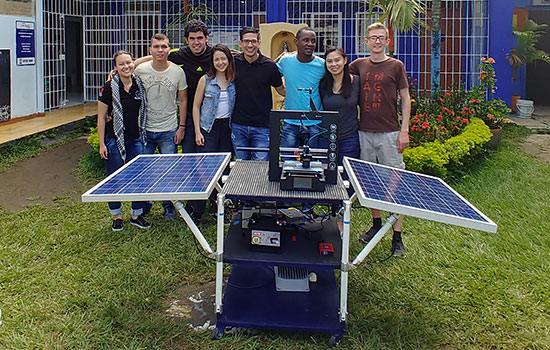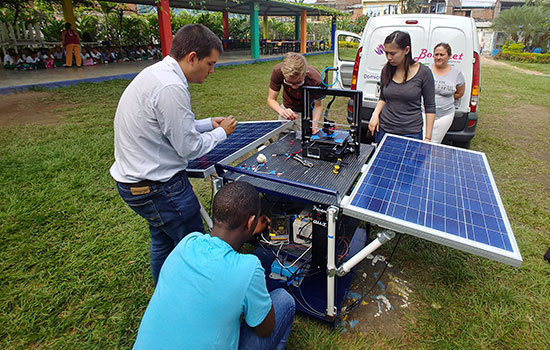Team creates solar-powered 3D printing system
The system was built for a multidisciplinary senior design project by students in RIT and UAO
RIT Students and Universidad Autónoma De Occidente Professor Alvaro Rojas set up the solar-powered 3D printer for a demonstration.
Rochester Institute of Technology engineering students and faculty traveled to Cali, Colombia, on May 28 to deliver and show residents how to use a new solar-powered 3D printing system they developed. The team, overseen by Associate Professor Marcos Esterman, worked with partners from the Universidad Autónoma de Occidente (UAO) throughout the spring semester to create the product. Project organizers intend the venture to help residents of a Cali neighborhood at high risk of attracting youth to gang activities to develop marketable skills in advanced manufacturing.
For their Multidisciplinary Senior Design course, six RIT electrical, industrial and mechanical engineering students created a versatile 3D printer power system that can seamlessly switch power sources for use in developing economies. The group collaborated remotely with UAO students who were tasked with simultaneously developing a way to use recycled plastic bottles as reinforcement in the 3D printing filament.
“The goal is to implement this printing system in Colombia because their electricity isn’t that reliable and because 3D printers need a constant flow of electricity to function,” said Josh Cohen, a fifth-year student from Newton, Mass., who worked on the project. “Having those backup power sources like the solar panels or the battery or also being able to plug into the grid are all things that will keep this printer up and running in the community.”
This project marks the first step in an agreement RIT and UAO reached last fall. The agreement aims to develop student and faculty project and research exchanges focused on international product design theory and commercialization for developing economies. The project was spearheaded by Esterman and his former student Alvaro Rojas Arciniegas ’08, ’13 (industrial engineering, imaging science), who is now a faculty member at UAO. Esterman hopes to build on the initial project’s success and expand the partnership into a series of interrelated programs that will help undergraduate and graduate students from both schools gain design and development experience while making a broader social impact.
“The more experiences that we can create for our students, the more realistic those experiences are, the better prepared they’re going to be to make an impact after graduation,” said Esterman. “Whether that impact is doing their own venture or working for a Fortune 500 company, the skills are very much transferrable and portable. We need to make, for this program in particular, entrepreneurship in a global environment real to our students and the sooner we can make that real, the better.”
RIT has numerous international partnerships, formal agreements and faculty/student exchanges with universities. International co-op experiences are also available to students and new arrangements for these opportunities continue to grow.
 RIT with partners from the Universidad Autónoma De Occidente set up their solar-powered 3D printer.
RIT with partners from the Universidad Autónoma De Occidente set up their solar-powered 3D printer.













